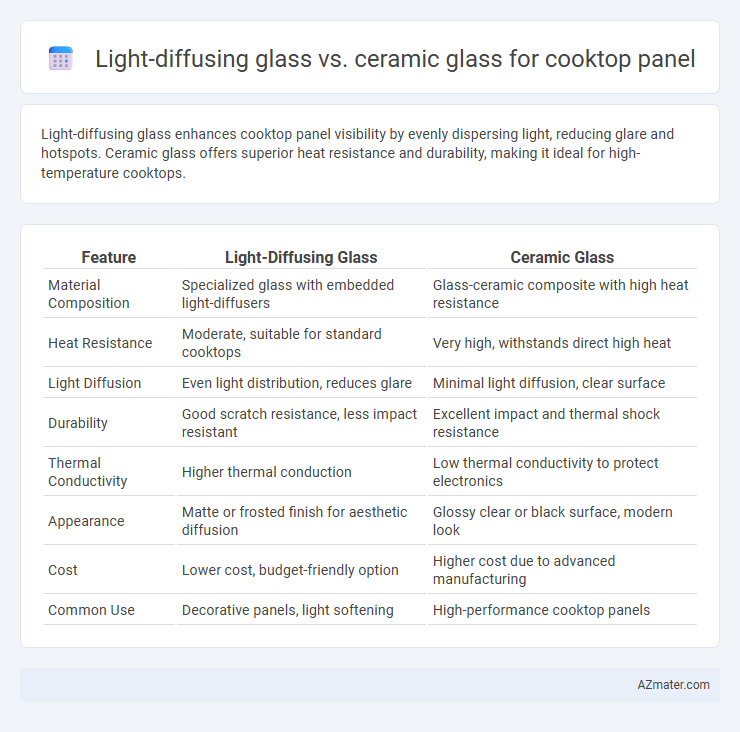Light-diffusing glass enhances cooktop panel visibility by evenly dispersing light, reducing glare and hotspots. Ceramic glass offers superior heat resistance and durability, making it ideal for high-temperature cooktops.
Table of Comparison
| Feature | Light-Diffusing Glass | Ceramic Glass |
|---|---|---|
| Material Composition | Specialized glass with embedded light-diffusers | Glass-ceramic composite with high heat resistance |
| Heat Resistance | Moderate, suitable for standard cooktops | Very high, withstands direct high heat |
| Light Diffusion | Even light distribution, reduces glare | Minimal light diffusion, clear surface |
| Durability | Good scratch resistance, less impact resistant | Excellent impact and thermal shock resistance |
| Thermal Conductivity | Higher thermal conduction | Low thermal conductivity to protect electronics |
| Appearance | Matte or frosted finish for aesthetic diffusion | Glossy clear or black surface, modern look |
| Cost | Lower cost, budget-friendly option | Higher cost due to advanced manufacturing |
| Common Use | Decorative panels, light softening | High-performance cooktop panels |
Introduction to Cooktop Panel Materials
Light-diffusing glass and ceramic glass are popular materials used for cooktop panels, each offering distinct thermal and optical properties. Ceramic glass provides exceptional heat resistance and durability, making it ideal for high-temperature cooking environments. Light-diffusing glass enhances visibility and safety by evenly distributing light, reducing glare while maintaining a sleek, modern appearance.
What is Light-Diffusing Glass?
Light-diffusing glass is engineered to scatter light evenly across its surface, reducing glare and enhancing visibility on cooktop panels. This glass type improves user interaction by providing uniform illumination, which is especially beneficial for touch controls and display indicators. Compared to ceramic glass, light-diffusing glass offers superior light transmission and clarity, contributing to a more intuitive cooking experience.
What is Ceramic Glass?
Ceramic glass is a heat-resistant, non-porous material made by fusing glass with ceramic components, offering superior thermal shock resistance compared to traditional glass. It provides excellent durability and can withstand high temperatures, making it ideal for cooktop panels that require frequent heating and cooling cycles. Unlike light-diffusing glass, ceramic glass maintains clarity and strength under intense heat while ensuring even heat distribution for efficient cooking performance.
Key Differences Between Light-Diffusing and Ceramic Glass
Light-diffusing glass for cooktop panels disperses reflected light evenly to reduce glare and enhance visibility of the cooking surface, while ceramic glass offers superior heat resistance and durability against high temperatures. Light-diffusing glass is primarily focused on optical clarity and aesthetic appeal, whereas ceramic glass provides robust thermal insulation and scratch resistance. The key difference lies in their functional priorities: light diffusion for visual comfort versus thermal endurance for safety and longevity in cooktop applications.
Heat Resistance and Thermal Performance
Light-diffusing glass for cooktop panels offers moderate heat resistance, typically withstanding temperatures up to 500degF (260degC), making it suitable for standard cooking environments with even heat distribution. Ceramic glass panels excel in thermal performance, resisting extreme temperatures up to 1200degF (650degC) and providing superior thermal shock resistance, which prevents cracking under rapid temperature changes. The enhanced durability of ceramic glass makes it the preferred choice for high-heat applications and extended cooktop longevity.
Durability and Scratch Resistance
Light-diffusing glass for cooktop panels offers enhanced scratch resistance due to its specialized coating that disperses light and hides minor abrasions. Ceramic glass excels in durability by withstanding high thermal shock and heavy impacts, making it ideal for frequent use cooktops. While light-diffusing glass improves surface longevity against scratches, ceramic glass provides superior structural resilience under intense cooking conditions.
Aesthetics and Design Flexibility
Light-diffusing glass offers a sleek, modern appearance with enhanced translucency that softens light and adds a sophisticated glow to cooktop panels, elevating kitchen aesthetics. Ceramic glass provides superior design flexibility due to its ability to withstand high temperatures and accommodate intricate patterns or colors without compromising durability. Both materials support stylish kitchen designs, but light-diffusing glass emphasizes elegance and subtle lighting effects, while ceramic glass excels in customization and heat resistance.
Energy Efficiency and Light Transmission
Light-diffusing glass enhances cooktop panel performance by scattering light to reduce glare while maintaining high energy efficiency through effective heat insulation, minimizing energy loss during cooking. Ceramic glass offers superior thermal resistance and durability, allowing it to withstand rapid temperature changes and retain heat efficiently, which contributes to overall energy savings. Light transmission in light-diffusing glass is optimized to ensure visible light dispersal, whereas ceramic glass typically allows direct light passage with minimal diffusion, impacting visual clarity and heat management on cooktop surfaces.
Maintenance and Cleaning Considerations
Light-diffusing glass cooktop panels typically require gentle cleaning with non-abrasive, pH-neutral cleaners to maintain their matte finish and prevent scratches. Ceramic glass surfaces are more resistant to staining and heat damage but demand careful removal of burnt-on residues using specialized scraper tools and ceramic cooktop cleaners. Both materials benefit from routine maintenance to preserve clarity and functionality, though ceramic glass generally offers easier cleanup due to its smooth, non-porous surface.
Choosing the Right Glass for Your Cooktop Panel
Light-diffusing glass enhances cooktop panels by evenly distributing heat and minimizing hotspots, improving cooking performance and safety. Ceramic glass offers exceptional heat resistance and durability, making it ideal for withstanding high temperatures and thermal shocks in cooktops. Choosing the right glass depends on balancing heat distribution needs with temperature tolerance and cleaning preferences for optimal kitchen efficiency.

Infographic: Light-diffusing glass vs Ceramic glass for Cooktop panel
 azmater.com
azmater.com